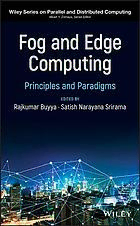
Fog and edge computing: principles and paradigms PDF
Preview Fog and edge computing: principles and paradigms
(cid:2) FogandEdgeComputing (cid:2) (cid:2) (cid:2) (cid:2) (cid:2) (cid:2) WileySeriesOnParallelandDistributedComputing SeriesEditor:AlbertY.Zomaya Acompletelistoftitlesinthisseriesappearsattheendofthisvolume. (cid:2) (cid:2) Fog and Edge Computing PrinciplesandParadigms EditedbyRajkumarBuyyaandSatishNarayanaSrirama (cid:2) (cid:2) (cid:2) (cid:2) Thiseditionfirstpublished2019 ©2019JohnWiley&Sons,Inc Allrightsreserved.Nopartofthispublicationmaybereproduced,storedinaretrievalsystem,or transmitted,inanyformorbyanymeans,electronic,mechanical,photocopying,recordingor otherwise,exceptaspermittedbylaw.Adviceonhowtoobtainpermissiontoreusematerialfrom thistitleisavailableathttp://www.wiley.com/go/permissions. TherightofRajkumarBuyyaandSatishNarayanaSriramatobeidentifiedastheauthorsofthe editorialmaterialinthisworkhasbeenassertedinaccordancewithlaw. RegisteredOffice JohnWiley&Sons,Inc.,111RiverStreet,Hoboken,NJ07030,USA EditorialOffice 111RiverStreet,Hoboken,NJ07030,USA Fordetailsofourglobaleditorialoffices,customerservices,andmoreinformationaboutWiley productsvisitusatwww.wiley.com. Wileyalsopublishesitsbooksinavarietyofelectronicformatsandbyprint-on-demand.Some contentthatappearsinstandardprintversionsofthisbookmaynotbeavailableinotherformats. LimitofLiability/DisclaimerofWarranty Whilethepublisherandauthorshaveusedtheirbesteffortsinpreparingthiswork,theymakeno representationsorwarrantieswithrespecttotheaccuracyorcompletenessofthecontentsofthis workandspecificallydisclaimallwarranties,includingwithoutlimitationanyimpliedwarranties ofmerchantabilityorfitnessforaparticularpurpose.Nowarrantymaybecreatedorextendedby salesrepresentatives,writtensalesmaterialsorpromotionalstatementsforthiswork.Thefact thatanorganization,website,orproductisreferredtointhisworkasacitationand/orpotential sourceoffurtherinformationdoesnotmeanthatthepublisherandauthorsendorsethe informationorservicestheorganization,website,orproductmayprovideorrecommendationsit (cid:2) maymake.Thisworkissoldwiththeunderstandingthatthepublisherisnotengagedin (cid:2) renderingprofessionalservices.Theadviceandstrategiescontainedhereinmaynotbesuitable foryoursituation.Youshouldconsultwithaspecialistwhereappropriate.Further,readersshould beawarethatwebsiteslistedinthisworkmayhavechangedordisappearedbetweenwhenthis workwaswrittenandwhenitisread.Neitherthepublishernorauthorsshallbeliableforanyloss ofprofitoranyothercommercialdamages,includingbutnotlimitedtospecial,incidental, consequential,orotherdamages. LibraryofCongressCataloging-in-PublicationData Names:Buyya,Rajkumar,1970-editor.|Srirama,SatishNarayana,1978- editor. Title:Fogandedgecomputing:principlesandparadigms/editedbyRajkumar Buyya,SatishNarayanaSrirama. Description:Hoboken,NJ,USA:JohnWiley&Sons,Inc.,2019.|Series: Wileyseriesonparallelanddistributedcomputing|Includes bibliographicalreferencesandindex.| Identifiers:LCCN2018054742(print)|LCCN2018057015(ebook)|ISBN 9781119525011(AdobePDF)|ISBN9781119525066(ePub)|ISBN9781119524984 (hardcover) Subjects:LCSH:Cloudcomputing.|Electronicdataprocessing–Distributed processing. Classification:LCCQA76.585(ebook)|LCCQA76.585.F632019(print)|DDC 004.67/82–dc23 LCrecordavailableathttps://lccn.loc.gov/2018054742 CoverdesignbyWiley Coverimage:©Shaxiaozi/iStock.com Setin10/12ptWarnockProbySPiGlobal,Chennai,India PrintedintheUnitedStatesforAmerica 10 9 8 7 6 5 4 3 2 1 (cid:2) (cid:2) v Contents ListofContributors xix Preface xxiii Acknowledgments xxvii PartI Foundations 1 1 InternetofThings(IoT)andNewComputingParadigms 3 (cid:2) ChiiChang,SatishNarayanaSrirama,andRajkumarBuyya (cid:2) 1.1 Introduction 3 1.2 RelevantTechnologies 6 1.3 FogandEdgeComputingCompletingtheCloud 8 1.3.1 AdvantagesofFEC:SCALE 8 1.3.1.1 Security 8 1.3.1.2 Cognition 8 1.3.1.3 Agility 9 1.3.1.4 Latency 9 1.3.1.5 Efficiency 9 1.3.2 HowFECAchievesTheseAdvantages:SCANC 9 1.3.2.1 Storage 9 1.3.2.2 Compute 10 1.3.2.3 Acceleration 10 1.3.2.4 Networking 11 1.3.2.5 Control 12 1.4 HierarchyofFogandEdgeComputing 13 1.4.1 Inner-Edge 13 1.4.2 Middle-Edge 14 1.4.2.1 LocalAreaNetwork 14 1.4.2.2 CellularNetwork 14 (cid:2) (cid:2) vi Contents 1.4.3 Outer-Edge 14 1.4.3.1 ConstraintDevices 14 1.4.3.2 IntegratedDevices 15 1.4.3.3 IPGatewayDevices 15 1.5 BusinessModels 16 1.5.1 XasaService 16 1.5.2 SupportService 16 1.5.3 ApplicationService 17 1.6 OpportunitiesandChallenges 17 1.6.1 Out-of-BoxExperience 17 1.6.1.1 OOBE-BasedEquipment 18 1.6.1.2 OOBE-BasedSoftware 18 1.6.2 OpenPlatforms 18 1.6.2.1 OpenStack++ 18 1.6.2.2 WSO2–IoTServer 18 1.6.2.3 ApacheEdgent 19 1.6.3 SystemManagement 19 1.6.3.1 Design 19 1.6.3.2 Implementation 19 1.6.3.3 Adjustment 20 1.7 Conclusions 20 (cid:2) (cid:2) References 21 2 AddressingtheChallengesinFederatingEdge Resources 25 AhmetCihatBaktir,CagataySonmez,CemErsoy,AtayOzgovde,and BlessonVarghese 2.1 Introduction 25 2.2 TheNetworkingChallenge 27 2.2.1 NetworkingChallengesinaFederatedEdgeEnvironment 28 2.2.1.1 AService-CentricModel 29 2.2.1.2 ReliabilityandServiceMobility 29 2.2.1.3 MultipleAdministrativeDomains 29 2.2.2 AddressingtheNetworkingChallenge 30 2.2.3 FutureResearchDirections 33 2.3 TheManagementChallenge 34 2.3.1 ManagementChallengesinaFederatedEdgeEnvironment 35 2.3.1.1 DiscoveringEdgeResources 35 2.3.1.2 DeployingServicesandApplications 35 2.3.1.3 MigratingServicesacrosstheEdge 36 2.3.1.4 LoadBalancing 36 2.3.2 CurrentResearch 36 2.3.3 AddressingtheManagementChallenges 37 (cid:2) (cid:2) Contents vii 2.3.3.1 Edge-as-a-Service(EaaS)Platform 37 2.3.3.2 EdgeNodeResourceManagement(ENORM)Framework 38 2.3.4 FutureResearchDirections 39 2.4 MiscellaneousChallenges 40 2.4.1 TheResearchChallenge 40 2.4.1.1 DefinedEdgeNodes 41 2.4.1.2 UnifiedArchitecturestoAccountforHeterogeneity 41 2.4.1.3 PublicUsabilityofEdgeNodes 41 2.4.1.4 InteroperabilitywithCommunicationNetworks 42 2.4.1.5 NetworkSlicesforEdgeSystems 42 2.4.2 TheModelingChallenge 43 2.4.2.1 ComputationalResourceModeling 43 2.4.2.2 DemandModeling 44 2.4.2.3 MobilityModeling 44 2.4.2.4 NetworkModeling 44 2.4.2.5 SimulatorEfficiency 44 2.5 Conclusions 45 References 45 3 IntegratingIoT+Fog+CloudInfrastructures:System (cid:2) (cid:2) ModelingandResearchChallenges 51 GutoLeoniSantos,MatheusFerreira,LeylaneFerreira,JudithKelner,Djamel Sadok,EdisonAlbuquerque,TheoLynn,andPatriciaTakakoEndo 3.1 Introduction 51 3.2 Methodology 52 3.3 IntegratedC2F2TLiteraturebyModelingTechnique 55 3.3.1 AnalyticalModels 58 3.3.2 PetriNetModels 61 3.3.3 IntegerLinearProgramming 63 3.3.4 OtherApproaches 64 3.4 IntegratedC2F2TLiteraturebyUse-CaseScenarios 65 3.5 IntegratedC2F2TLiteraturebyMetrics 68 3.5.1 EnergyConsumption 68 3.5.2 Performance 70 3.5.3 ResourceConsumption 70 3.5.4 Cost 71 3.5.5 QualityofService 71 3.5.6 Security 72 3.6 FutureResearchDirections 72 3.7 Conclusions 73 Acknowledgments 74 References 75 (cid:2) (cid:2) viii Contents 4 ManagementandOrchestrationofNetworkSlicesin5G,Fog, Edge,andClouds 79 AdelNadjaranToosi,RedowanMahmud,QinghuaChi,andRajkumarBuyya 4.1 Introduction 79 4.2 Background 80 4.2.1 5G 80 4.2.2 CloudComputing 82 4.2.3 MobileEdgeComputing(MEC) 82 4.2.4 EdgeandFogComputing 82 4.3 NetworkSlicingin5G 83 4.3.1 InfrastructureLayer 84 4.3.2 NetworkFunctionandVirtualizationLayer 85 4.3.3 ServiceandApplicationLayer 85 4.3.4 SlicingManagementandOrchestration(MANO) 86 4.4 NetworkSlicinginSoftware-DefinedClouds 87 4.4.1 Network-AwareVirtualMachinesManagement 88 4.4.2 Network-AwareVirtualMachineMigrationPlanning 88 4.4.3 VirtualNetworkFunctionsManagement 89 4.5 NetworkSlicingManagementinEdgeandFog 91 4.6 FutureResearchDirections 93 (cid:2) 4.6.1 Software-DefinedClouds 93 (cid:2) 4.6.2 EdgeandFogComputing 95 4.7 Conclusions 96 Acknowledgments 96 References 96 5 OptimizationProblemsinFogandEdgeComputing 103 ZoltánÁdámMann 5.1 Introduction 103 5.2 Background/RelatedWork 104 5.3 Preliminaries 105 5.4 TheCaseforOptimizationinFogComputing 107 5.5 FormalModelingFrameworkforFogComputing 108 5.6 Metrics 109 5.6.1 Performance 109 5.6.2 ResourceUsage 110 5.6.3 EnergyConsumption 111 5.6.4 FinancialCosts 111 5.6.5 FurtherQualityAttributes 112 5.7 OptimizationOpportunitiesalongtheFogArchitecture 113 5.8 OptimizationOpportunitiesalongtheServiceLifeCycle 114 5.9 TowardaTaxonomyofOptimizationProblemsinFog Computing 115 (cid:2) (cid:2) Contents ix 5.10 OptimizationTechniques 117 5.11 FutureResearchDirections 118 5.12 Conclusions 119 Acknowledgments 119 References 119 PartII Middlewares 123 6 MiddlewareforFogandEdgeComputing:Design Issues 125 MadhurimaPore,VinayaChakati,AyanBanerjee,andSandeepK.S.Gupta 6.1 Introduction 125 6.2 NeedforFogandEdgeComputingMiddleware 126 6.3 DesignGoals 126 6.3.1 Ad-HocDeviceDiscovery 127 6.3.2 Run-TimeExecutionEnvironment 127 6.3.3 MinimalTaskDisruption 127 6.3.4 OverheadofOperationalParameters 127 6.3.5 Context-AwareAdaptiveDesign 128 (cid:2) 6.3.6 QualityofService 128 (cid:2) 6.4 State-of-the-ArtMiddlewareInfrastructures 128 6.5 SystemModel 129 6.5.1 EmbeddedSensorsorActuators 130 6.5.2 PersonalDevices 130 6.5.3 FogServers 131 6.5.4 Cloudlets 131 6.5.5 CloudServers 131 6.6 ProposedArchitecture 131 6.6.1 APICode 132 6.6.2 Security 132 6.6.2.1 Authentication 132 6.6.2.2 Privacy 133 6.6.2.3 Encryption 133 6.6.3 DeviceDiscovery 133 6.6.4 Middleware 133 6.6.4.1 ContextMonitoringandPrediction 133 6.6.4.2 SelectionofParticipatingDevices 134 6.6.4.3 DataAnalytics 134 6.6.4.4 SchedulingandResourceManagement 135 6.6.4.5 NetworkManagement 135 6.6.4.6 ExecutionManagement 135 6.6.4.7 MobilityManagement 135 (cid:2) (cid:2) x Contents 6.6.5 Sensor/Actuators 136 6.7 CaseStudyExample 136 6.8 FutureResearchDirections 137 6.8.1 HumanInvolvementandContextAwareness 137 6.8.2 Mobility 137 6.8.3 SecureandReliableExecution 137 6.8.4 ManagementandSchedulingofTasks 138 6.8.5 ModularityforDistributedExecution 138 6.8.6 BillingandService-LevelAgreement(SLA) 138 6.8.7 Scalability 138 6.9 Conclusions 139 References 139 7 ALightweightContainerMiddlewareforEdgeCloud Architectures 145 DavidvonLeon,LorenzoMiori,JulianSanin,NabilElIoini,SvenHelmer,and ClausPahl 7.1 Introduction 145 7.2 Background/RelatedWork 146 7.2.1 EdgeCloudArchitectures 146 (cid:2) 7.2.2 AUseCase 148 (cid:2) 7.2.3 RelatedWork 149 7.3 ClustersforLightweightEdgeClouds 149 7.3.1 LightweightSoftware–Containerization 149 7.3.2 LightweightHardware–RaspberryPiClusters 151 7.4 ArchitectureManagement–StorageandOrchestration 152 7.4.1 Own–BuildClusterStorageandOrchestration 152 7.4.1.1 Own–BuildClusterStorageandOrchestrationArchitecture 152 7.4.1.2 UseCaseandExperimentation 153 7.4.2 OpenStackStorage 153 7.4.2.1 StorageManagementArchitecture 153 7.4.2.2 UseCaseandExperimentation 154 7.4.3 DockerOrchestration 154 7.4.3.1 DockerOrchestrationArchitecture 155 7.4.3.2 DockerEvaluation–Installation,Performance,Power 157 7.5 IoTIntegration 159 7.6 SecurityManagementforEdgeCloudArchitectures 159 7.6.1 SecurityRequirementsandBlockchainPrinciples 160 7.6.2 ABlockchain-BasedSecurityArchitecture 161 7.6.3 IntegratedBlockchain-BasedOrchestration 163 7.7 FutureResearchDirections 165 7.8 Conclusions 166 References 167 (cid:2)
